About smart alerts
With the help of the Odoo app, Smart alert, you will always remember important details of your deals, while working with documents. Smart alerts are used to inform or warn users in the most convenient place - when they work with document forms. With smart alerts you will be able to:
Prepare alert for any Odoo document type
Choose among 4 types of alerts that differ in color
Flexible restrict documents types for alert
Configure warning to show only for specific groups of users
Highlight some words using simple HTML code
Choose a company, where you want the alert to be shown
Find smart alerts above a document form. Alerts are located above a form view to always meet the eye of any user who opens this document. Such warnings are updated each time a form is reloaded: when you open a record, when you save a document, when you switch to the next record, etc.
Alerts may be translated and, then, would be shown in a current user language. The tool is also compatible with multi companies: each branch would have its own list of alerts.
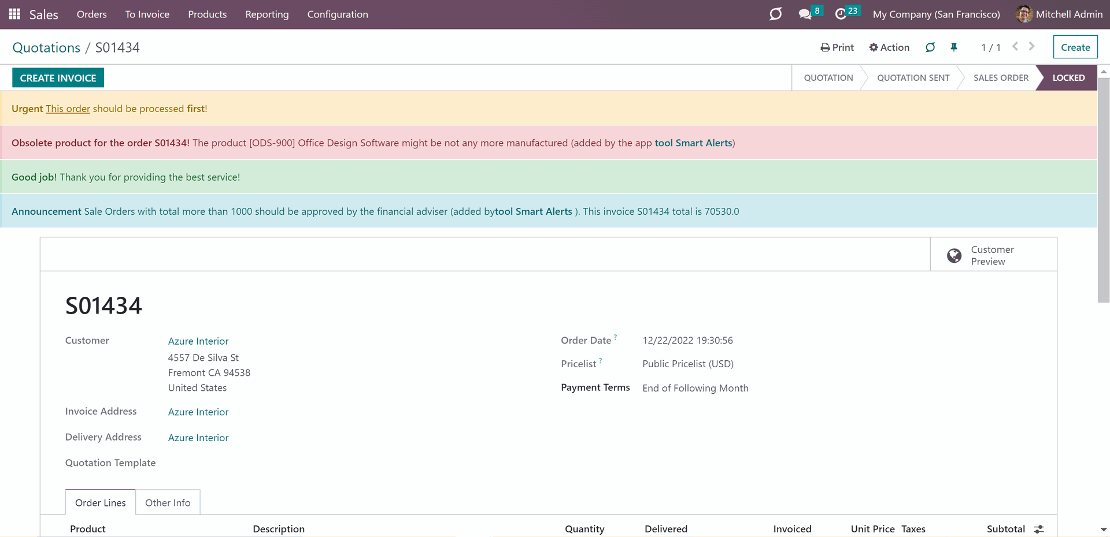
Managing smart alerts
There are 4 available types of alerts, they differ by color: Danger (red), Warning (orange), Info (blue), and Success (green). You can't add other colors, but you can edit alert titles. You can add many alerts of the same type.
How to create a smart alert:
1. Open the Smart alerts app
2. Click 'New'
3. Write an Alert title (the title will be seen in bold, before an alert text)
4. Fill the field 'Alert text' (will be seen)
5. Choose a document type, where you want to see your alerts
6. Choose a type of alert
7. Choose user groups that will see the alert, or leave the field empty if you want everyone to see it
8. If you have several companies, choose the company for showing alerts, otherwise, alerts would be shown to all companies
9. Add some filters to add alerts automatically to matching documents, and do not show for others
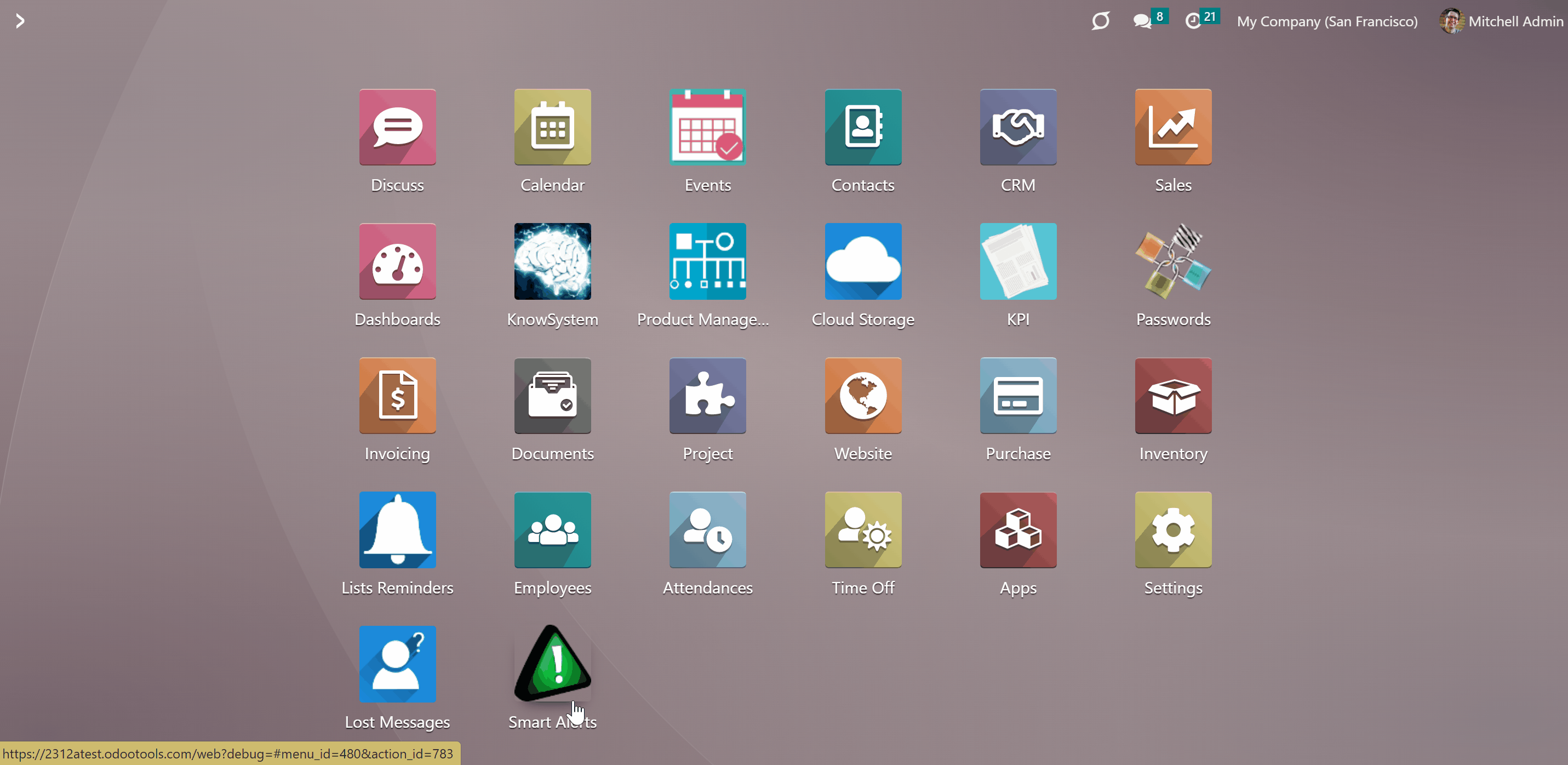
How to edit a smart alert:
1. Open the Smart alerts app
2. Click on the alert you want to change
3. Change anything the way you like
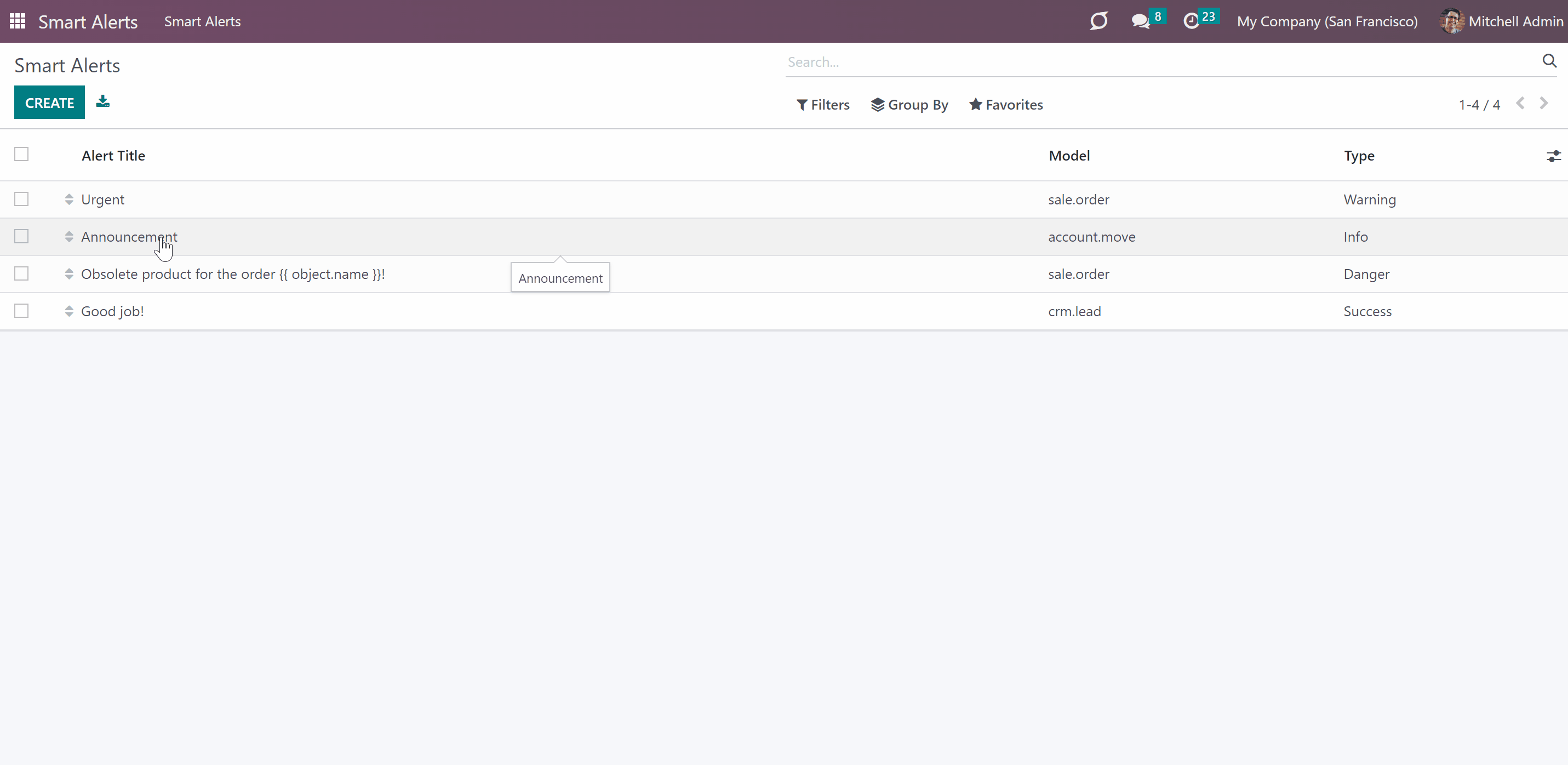
How to delete a smart alert:
1. Open the Smart alerts app
2. On the left side tick the empty squares of the alerts you want to delete
3. Above will appear a gear sign
4. Click it and choose an action
5. Available actions are export, archive, unarchive, delete

Smart alerts can be added to all stored models available in your Odoo. A model might be chosen as a document type for smart alerts as soon as a related module is installed. For instance, if you install the Odoo CRM application, then it will be possible to configure warnings for opportunities or sales teams.
Keep in mind, that smart alerts admins might choose only those models, to which they have access. For example, if Abigail Peterson is a sales manager, then she can work with quotations. As a smart alerts admin, she will be able to add alerts to those quotations. But John Brown, who is only a project user, cannot do that but he can configure warnings for tasks or projects.
This logic is equally correct for custom apps and their linked models. As you implement a new class to your database, it would be immediately available for smart alerts. Make sure that you grant proper access rights for your model. The principle is still the same: only those who can access its objects would be able to configure warnings for that model. So, the model, that you want to use should have at least one class, that can access it, for example, Odoo administrators.
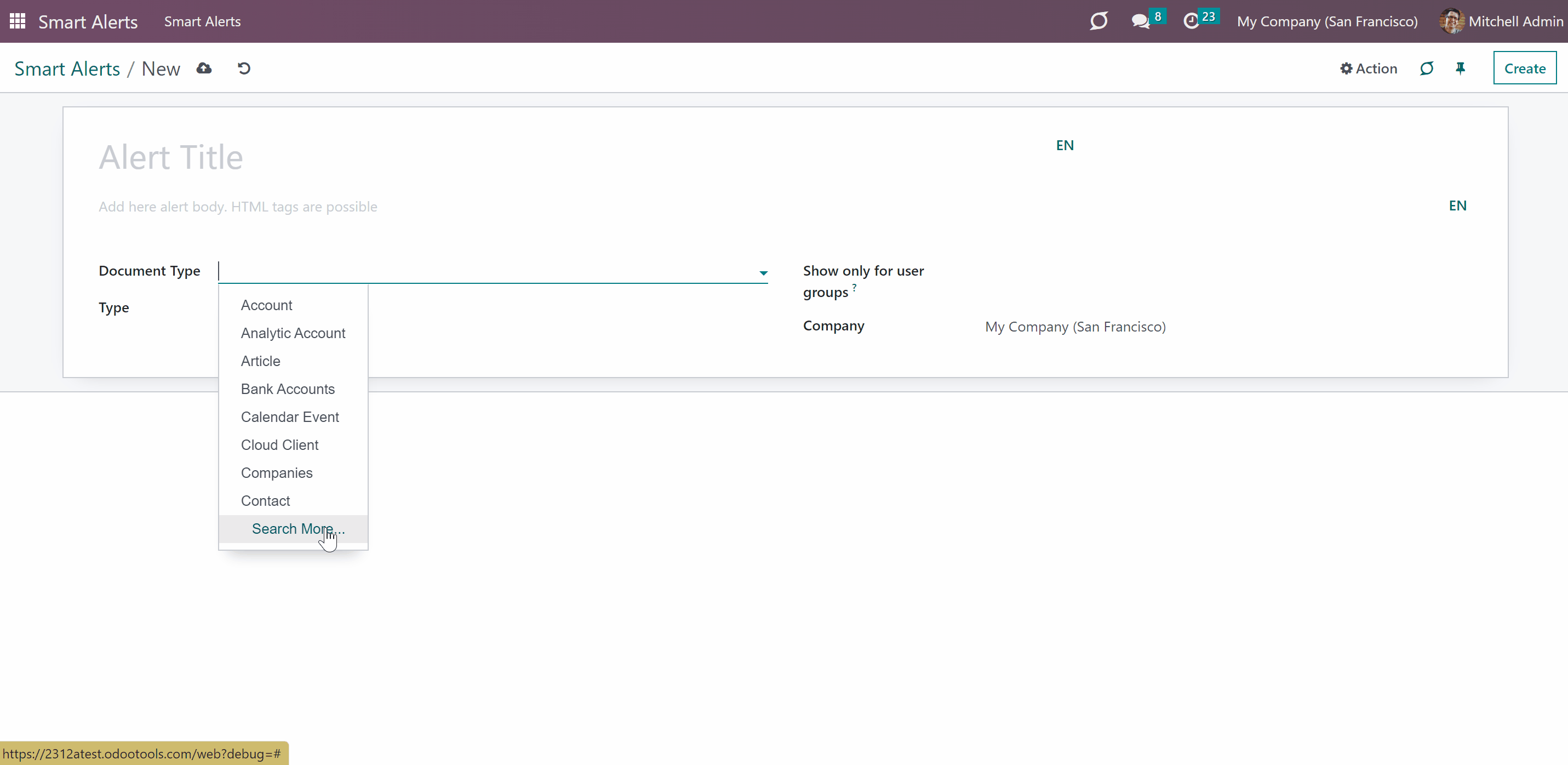
Using smart alerts and interfaces
Prepare alerts for any Odoo document type: sale orders, opportunities, contacts, pickings, so, any existing in your database.
Alerts are located above a form view to always meet the eye of any user who opens this document. Such warnings are updated each time a form is reloaded: when you open a record when you save a document when you switch to the next record, etc.
There might be an unlimited number of warnings for each document.
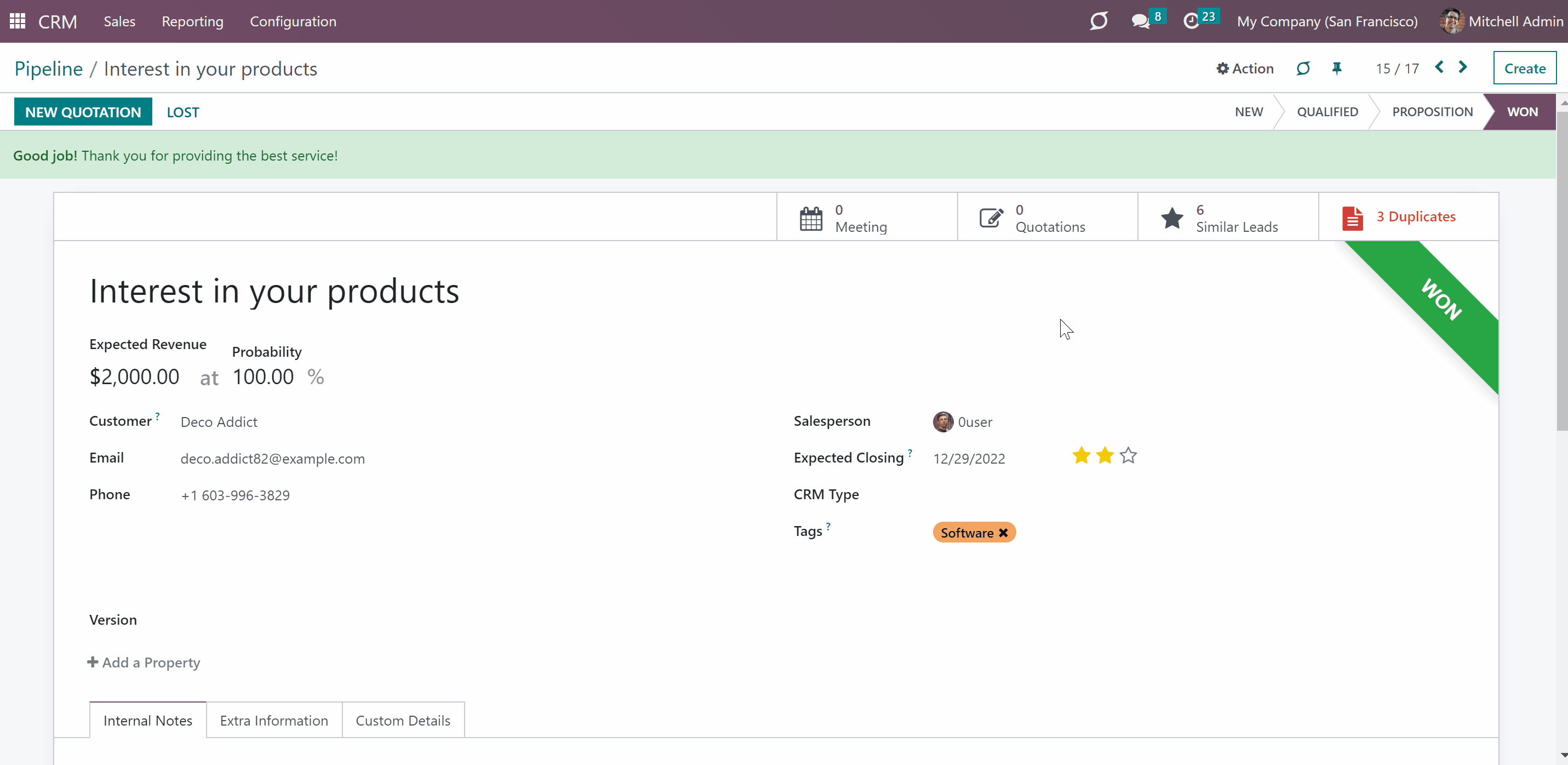
HTML tags. Fields 'Warning text' and 'Alert title' support simple HTML tags. You can make text, or part of the text bold, write in italics or add a link.
Here are some examples of simple HTML tags, that work:
The alert title is always in bold.
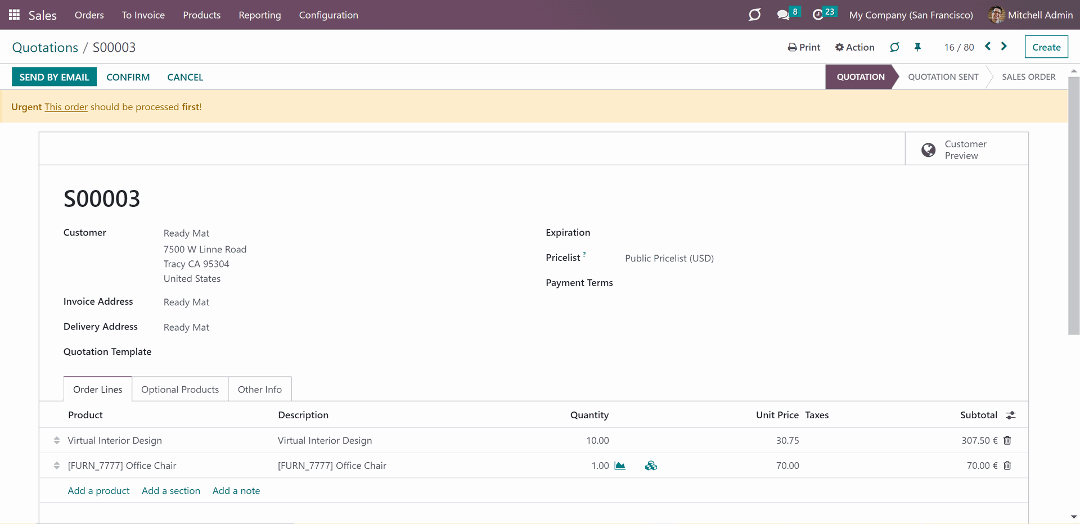
How to add HTML code:
1. Open the Smart alerts app
2. Click 'New'
3. Write an Alert title (the title will be seen in bold, before alert text)
4. If you want your title to be in italics as well, add <i> before your title and </i> after it
5. Write your text in the field 'Alert text'
6. If you want to underline several words, write <u> before them and </u> after them
7. Edit the text the way you like
You can apply a simple HTML code either to the whole text or to some words
You can add several codes in one sentence to different words, or several codes to one word, so it will be written both in bold and italics.
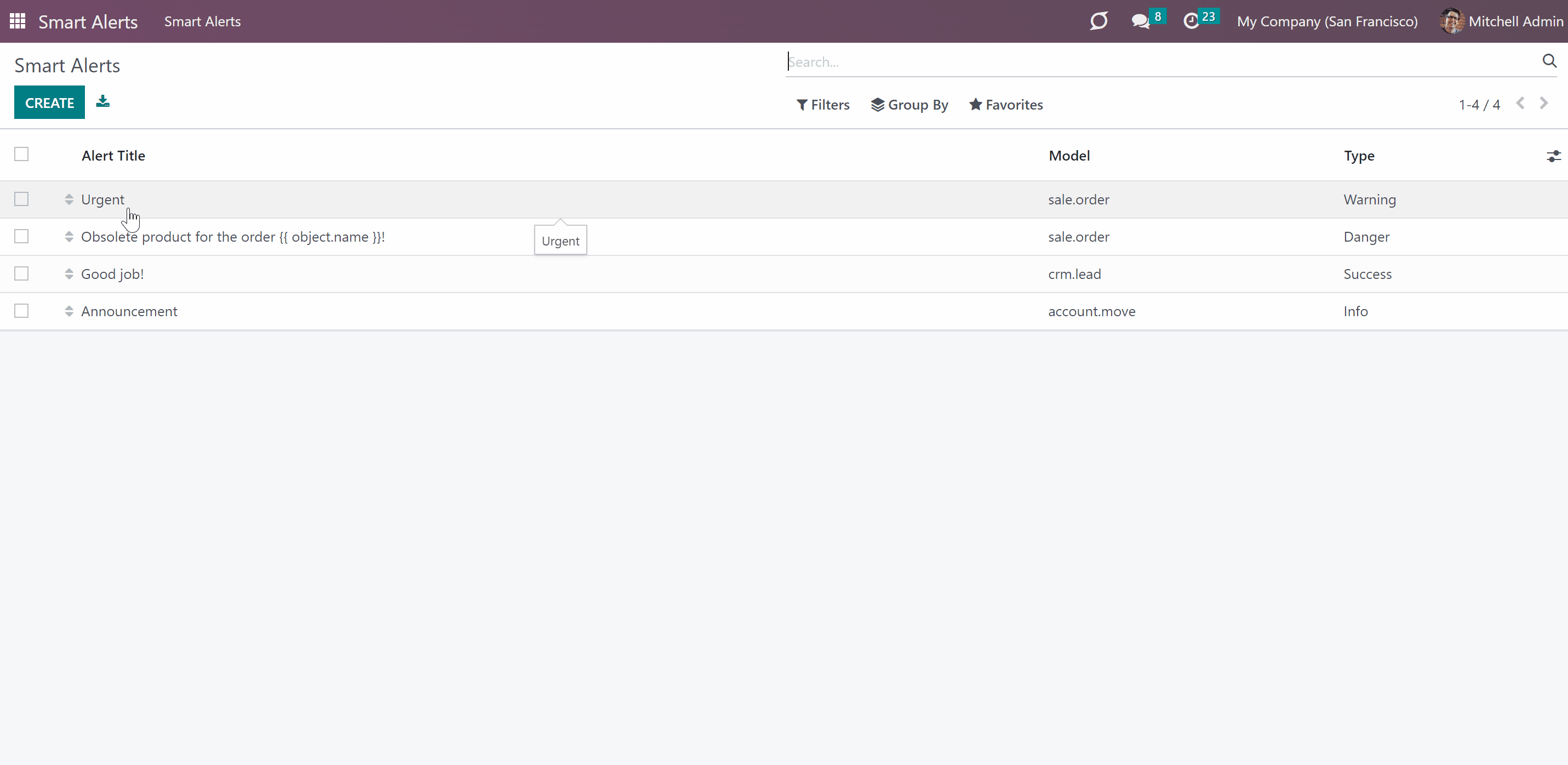
Rules for assigning smart alerts
Creating automatic rules allows you to apply your smart alerts to all documents that match the specified conditions automatically. If you delete an automatic rule, then the list of matching documents will change. If you edit it, the list of marked documents will change.
Flexible restrict documents for alerts. You can apply filters by any storable field. For example, make announcements only for quotations (not sale orders), warn of invoices with a total between 500 and 1000, pay attention only to suppliers (not customers), etc.
Here we provide some examples of automatic rules. Use:
To state that some products are no longer available (document type = Sales order).
To alert that this tasks should be done on the first place (document type = Projects).
To show that this meeting is going to be long (document type = Event).
To remember not to accept orders from this client (document type = Contact).
To find all leads that are for services not for products (document type = Leads/Opportunities).
It is possible to set a complex color code classifier, so documents will match ALL of the rules or ANY of them.
How to add complex automatic rules:
1. Open the Smart alerts app
2. Click 'New'
3. Write an Alert title (the title will be seen in bold, before alert text)
4. Fill the field 'Alert text' (will be seen)
5. Choose the document type, where you want to see your alerts
6. Choose a type of alert
7. Choose user groups that will see the alert, or leave the field empty if you want everyone to see it
8. If you have several companies, choose the company for showing alerts, otherwise will be shown to all companies
9. Click '+Add Filter'
10. Choose filter options, by scrolling or typing the beginning in the search field and choose the filter options
11. Click on '+' on the right side of the rule you wrote
12. You will see one more line, where you can add new filter options
13. Now you have more than one rule and can choose ANY or ALL button above, so only documents that match ANY of the rules or ALL rules will be shown
14. Click on '...' button, on the right side near '+' to add an even more complex rule
15. Here you can also choose to filter documents that match ALL or ANY rules
16. If you choose ALL or ANY both times, your rules will stand in one line and only one button will remain
Open the Smart alerts app, choose an alert, click on an automatic rule, and push the button 'Records' to see Odoo documents that match the rule terms.
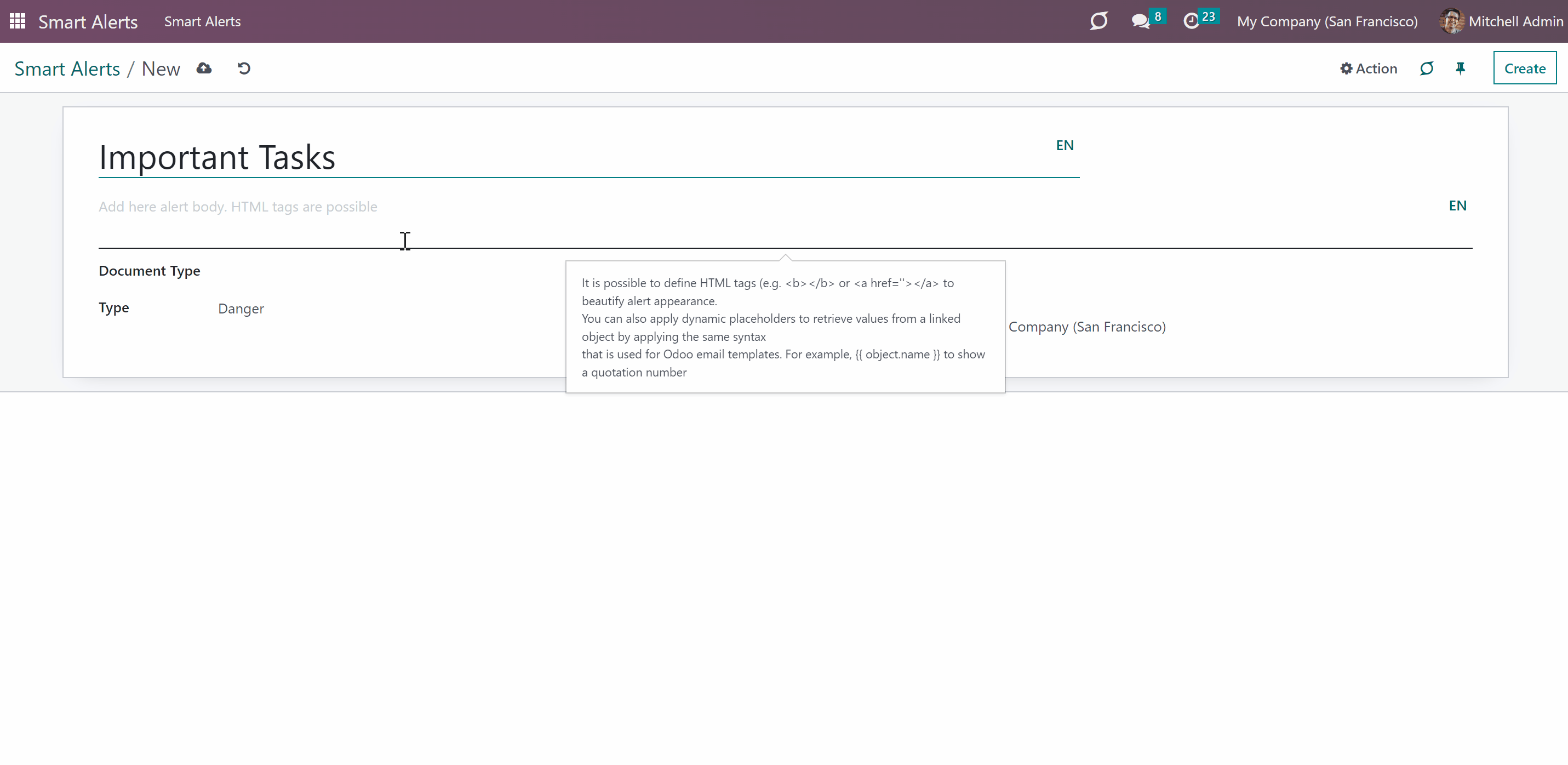
User rights in smart alerts
Generally, smart alerts are shown to all user groups. You can choose to show your smart alerts only for some specific groups while editing your alerts in the field 'Show only for user groups'.
The right to configure alerts belongs to the special user group - 'Other / Smart Alerts Admin', and you can assign employees to add and edit smart alerts.
To let the user configure smart alerts:
1. Go to general settings
2. Click 'Manage users'
3. Choose the user
4. Scroll down and find the section 'Productivity'
5. In the field 'Smart Alerts' choose the option 'Smart alerts admin'
6. After that the user will see the Smart alerts app in the menu and will be able to create and manage any related ones to his/her company
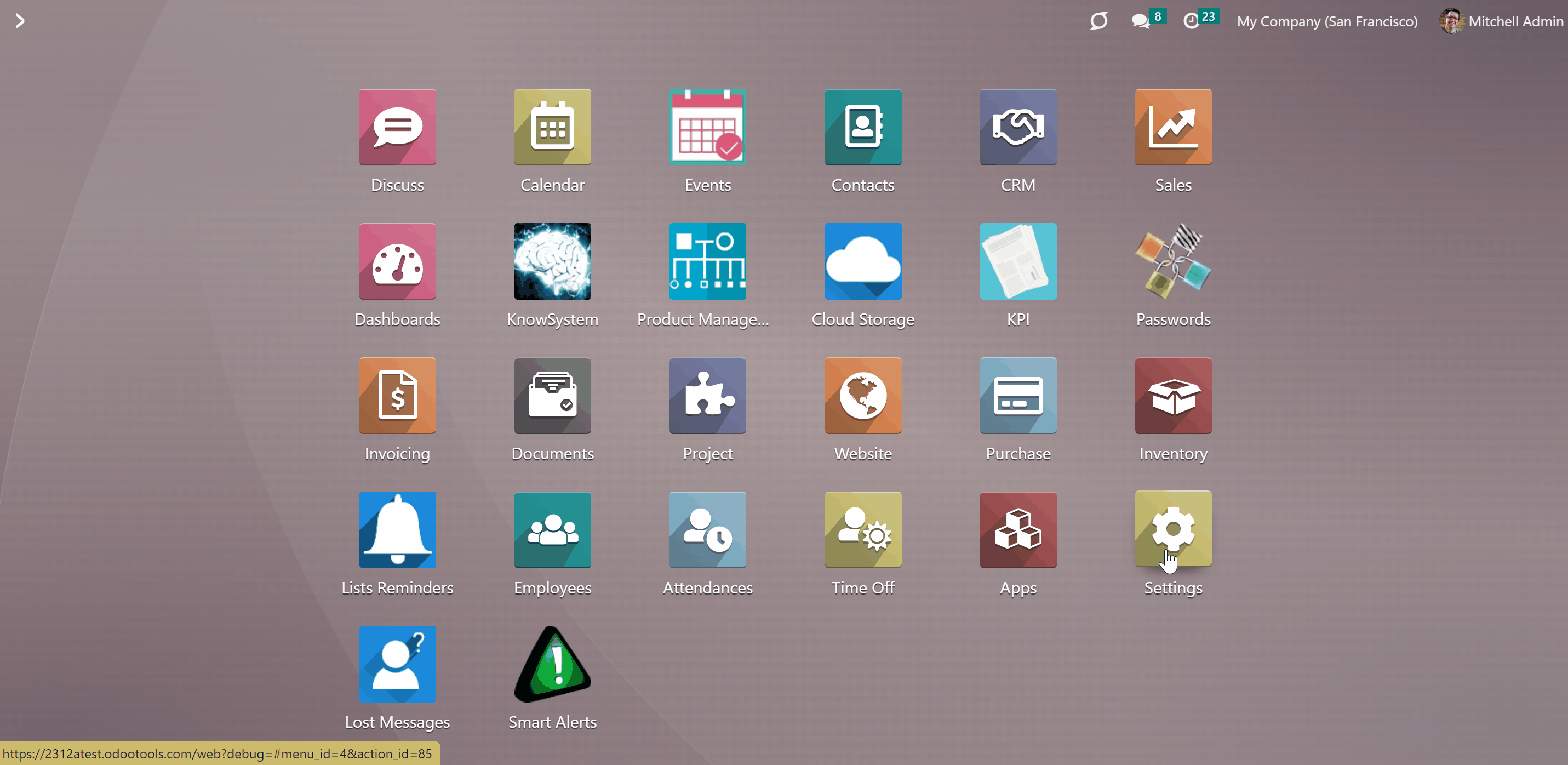
About smart alerts
With the help of the Odoo app, Smart alert, you will always remember important details of your deals, while working with documents. Smart alerts are used to inform or warn users in the most convenient place - when they work with document forms. With smart alerts you will be able to:
Prepare alert for any Odoo document type
Choose among 4 types of alerts that differ in color
Flexible restrict documents types for alert
Configure warning to show only for specific groups of users
Highlight some words using simple HTML code
Choose a company, where you want the alert to be shown
Find smart alerts above a document form. Alerts are located above a form view to always meet the eye of any user who opens this document. Such warnings are updated each time a form is reloaded: when you open a record, when you save a document, when you switch to the next record, etc.
Alerts may be translated and, then, would be shown in a current user language. The tool is also compatible with multi companies: each branch would have its own list of alerts.

Managing smart alerts
There are 4 available types of alerts, they differ by color: Danger (red), Warning (orange), Info (blue), and Success (green). You can't add other colors, but you can edit alert titles. You can add many alerts of the same type.
How to create a smart alert:
1. Open the Smart alerts app
2. Click 'New'
3. Write an Alert title (the title will be seen in bold, before an alert text)
4. Fill the field 'Alert text' (will be seen)
5. Choose a document type, where you want to see your alerts
6. Choose a type of alert
7. Choose user groups that will see the alert, or leave the field empty if you want everyone to see it
8. If you have several companies, choose the company for showing alerts, otherwise, alerts would be shown to all companies
9. Add some filters to add alerts automatically to matching documents, and do not show for others

How to edit a smart alert:
1. Open the Smart alerts app
2. Click on the alert you want to change
3. Change anything the way you like

How to delete a smart alert:
1. Open the Smart alerts app
2. On the left side tick the empty squares of the alerts you want to delete
3. Above will appear a gear sign
4. Click it and choose an action
5. Available actions are export, archive, unarchive, delete

Smart alerts can be added to all stored models available in your Odoo. A model might be chosen as a document type for smart alerts as soon as a related module is installed. For instance, if you install the Odoo CRM application, then it will be possible to configure warnings for opportunities or sales teams.
Keep in mind, that smart alerts admins might choose only those models, to which they have access. For example, if Abigail Peterson is a sales manager, then she can work with quotations. As a smart alerts admin, she will be able to add alerts to those quotations. But John Brown, who is only a project user, cannot do that but he can configure warnings for tasks or projects.
This logic is equally correct for custom apps and their linked models. As you implement a new class to your database, it would be immediately available for smart alerts. Make sure that you grant proper access rights for your model. The principle is still the same: only those who can access its objects would be able to configure warnings for that model. So, the model, that you want to use should have at least one class, that can access it, for example, Odoo administrators.

Using smart alerts and interfaces
Prepare alerts for any Odoo document type: sale orders, opportunities, contacts, pickings, so, any existing in your database.
Alerts are located above a form view to always meet the eye of any user who opens this document. Such warnings are updated each time a form is reloaded: when you open a record when you save a document when you switch to the next record, etc.
There might be an unlimited number of warnings for each document.

HTML tags. Fields 'Warning text' and 'Alert title' support simple HTML tags. You can make text, or part of the text bold, write in italics or add a link.
Here are some examples of simple HTML tags, that work:
The alert title is always in bold.

How to add HTML code:
1. Open the Smart alerts app
2. Click 'New'
3. Write an Alert title (the title will be seen in bold, before alert text)
4. If you want your title to be in italics as well, add <i> before your title and </i> after it
5. Write your text in the field 'Alert text'
6. If you want to underline several words, write <u> before them and </u> after them
7. Edit the text the way you like
You can apply a simple HTML code either to the whole text or to some words
You can add several codes in one sentence to different words, or several codes to one word, so it will be written both in bold and italics.

Rules for assigning smart alerts
Creating automatic rules allows you to apply your smart alerts to all documents that match the specified conditions automatically. If you delete an automatic rule, then the list of matching documents will change. If you edit it, the list of marked documents will change.
Flexible restrict documents for alerts. You can apply filters by any storable field. For example, make announcements only for quotations (not sale orders), warn of invoices with a total between 500 and 1000, pay attention only to suppliers (not customers), etc.
Here we provide some examples of automatic rules. Use:
To state that some products are no longer available (document type = Sales order).
To alert that this tasks should be done on the first place (document type = Projects).
To show that this meeting is going to be long (document type = Event).
To remember not to accept orders from this client (document type = Contact).
To find all leads that are for services not for products (document type = Leads/Opportunities).
It is possible to set a complex color code classifier, so documents will match ALL of the rules or ANY of them.
How to add complex automatic rules:
1. Open the Smart alerts app
2. Click 'New'
3. Write an Alert title (the title will be seen in bold, before alert text)
4. Fill the field 'Alert text' (will be seen)
5. Choose the document type, where you want to see your alerts
6. Choose a type of alert
7. Choose user groups that will see the alert, or leave the field empty if you want everyone to see it
8. If you have several companies, choose the company for showing alerts, otherwise will be shown to all companies
9. Click '+Add Filter'
10. Choose filter options, by scrolling or typing the beginning in the search field and choose the filter options
11. Click on '+' on the right side of the rule you wrote
12. You will see one more line, where you can add new filter options
13. Now you have more than one rule and can choose ANY or ALL button above, so only documents that match ANY of the rules or ALL rules will be shown
14. Click on '...' button, on the right side near '+' to add an even more complex rule
15. Here you can also choose to filter documents that match ALL or ANY rules
16. If you choose ALL or ANY both times, your rules will stand in one line and only one button will remain
Open the Smart alerts app, choose an alert, click on an automatic rule, and push the button 'Records' to see Odoo documents that match the rule terms.

User rights in smart alerts
Generally, smart alerts are shown to all user groups. You can choose to show your smart alerts only for some specific groups while editing your alerts in the field 'Show only for user groups'.
The right to configure alerts belongs to the special user group - 'Other / Smart Alerts Admin', and you can assign employees to add and edit smart alerts.
To let the user configure smart alerts:
1. Go to general settings
2. Click 'Manage users'
3. Choose the user
4. Scroll down and find the section 'Productivity'
5. In the field 'Smart Alerts' choose the option 'Smart alerts admin'
6. After that the user will see the Smart alerts app in the menu and will be able to create and manage any related ones to his/her company
